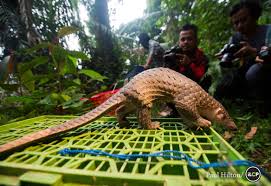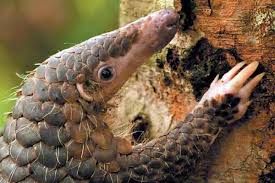The Pangolin: 13 facts about world’s most endangered mammal – Flora Bagnall
With its armoured shell and peculiar gait, the humble pangolin (or Scaly Anteater) looks more like an anteater prepped for medieval battle than an animal under threat. Illegal trade in South Asia, however, has now rendered the scaly mammals the most trafficked animal on earth, with some estimates claiming that sales now account for up to 20 per cent of the entire wildlife black market.
In response to the pangolin’s plight, numerous campaigns have been launched to raise awareness, including the SavePangolins organisation and an app, Roll with the Pangolins, which was endorsed by Prince William in his role as President of United for Wildlife. What’s more, in 2012 Sir David Attenborough chose the Sunda pangolin, a species distributed throughout South East Asia, as one of his ten favourite species he would ‘save’ from extinction.
So what is it that makes pangolin so special, and why has nobody heard of them? Here are 13 facts to get you up to speed on one of the most threatened species on Earth.
1) There are eight species of pangolin.
From one family, Manidae, there are eight species of pangolin still in existence worldwide, as well as several extinct species over their 80 million year evolution. Four of the species are Asian: Chinese, Malayan (or Sunda), Indian and Palawan; while the others are African: Tree pangolin, Giant ground pangolin, Cape pangolin and Long-tailed pangolin.
2) A pangolin’s tongue can be longer than its body
When fully extended, a pangolin’s tongue can be over 40cm long, and starts deep in the chest cavity. Pangolin do not have teeth and are unable to chew, so use their sticky tongues to collect insects, up to 70 million a year which, are ground up by stones and spine like structures within inside their stomachs.
3) Pangolins are the only mammals in the world covered in scales
The pangolin’s large scales are made of keratin, the same material of which our fingernails, rhino horns and bird talons are made, and account for 20% of its weight. The scales are very hard and protect pangolin against animal predators, yet in traditional Chinese medicine are dried and roasted as a method of relieving palsy, stimulating lactation and draining pus. As a result, pangolin scales can sell on the black market for over $3,000 a kilogram, and have even been used to make coats.
4) The name means ‘something that rolls up’

The ground pangolin got its common name from the Malay (the national language of Malaysia, Brunei and Indonesia) word ‘pengguling’, meaning ‘rolling up’, in reference to the animal’s defence mechanism of rolling into a tight, near-impenetrable ball when threatened. Unfortunately, this practice makes it even easier for humans to capture and smuggle them, as hunters can simply pick up.
5) Some climb trees, others dig holes
With their large, curved claws, pangolins are able both to grip on to overhanging tree branches and dig through concrete. Arboreal pangolins, such as the African long-tailed species, live in trees, while others dig burrows so large a human could stand up in them.
6) Even big cats don’t know what to do with them
Aside from humans, pangolins’ main predators include lions, tigers and leopards. Often, though, rolling up in a ball is enough to outwit the big cats, as a pangolin’s keratin scales are too hard for even a lion to bite through.
7) Nobody knows how long they live
It is presumed that pangolins have a lifespan of twenty years in the wild, since the oldest recorded pangolin lived for 19 years in captivity. The creatures are very rarely found in zoos, however, as time spent in captivity tends to bring about stress, depression and malnutrition, leading to early death. As such, it is unknown how long a pangolin can live for.
8) They emit a noxious acid like skunks
When threatened, pangolins defend themselves by rolling up in a ball and, if needed, lashing out with their tale, the scales on which can easily cut a predator’s skin. In addition they are also able to emit a noxious-smelling acid from glands near the arse, similar to the that of a skunk, though pangolins are unable to spray the liquid.
9) Millions have been traded and killed in the last decade
It is estimated that 100,000 pangolins are captured every year from across Africa and Asia, with most shipped to China and Vietnam, where their meat and scales are sold. As a result, all eight species of pangolin now feature on the International Union for the Conservation of Nature (IUCN) Red List of animals threatened with extinction.

As ever, it is man who provides the greatest threat to another endangered animal.
10) Their eyesight is dreadful
Of the eight species of pangolin only one, the long-tailed pangolin native to west and central Africa, is regularly active during the day. The rest are nocturnal and, relative to their body size, have very small eyes. This means they have poor eyesight, instead locating termite mounds and ant hills with a strong sense of smell and hearing.
12) Dating can be difficult
Pangolins are sexually dimorphic, meaning the genders differ wildly in weight. Most male pangolins are up to 50 per cent heavier than females, while the Indian species can reach 90 per cent. There is no defined mating season, and pangolins are largely solitary aside from mating, so males attract the opposite gender by marking their territory with urine and waiting for a female to find them.

13) Their closest relative might not be an anteater
They may be prehistoric, but d spite their nickname scientists have changed their minds over the taxonomy of pangolins. It was previously thought the mammals were a member of the Xenarthra family, which includes the similar-looking anteaters, sloths and armadillos. New evidence, however, has shown a closer relationship to the Carnivora, a diverse order containing hyenas, bears and wolves.















Post Comment
You must be logged in to post a comment.